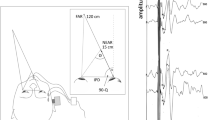Summary
Rotatory evoked late potentials following clockwise and counterclockwise rotational acceleration were measured in subjects with normal labyrinthine function and in patients with unilateral and bilateral vestibular loss. In the normal subjects the threshold of the evoked cortical responses ranged between 4°/s2 and 7°/s2, independent of the direction of rotation. For patients with unilateral vestibular loss thresholds were found to be dependent on the direction of rotation. The difference in threshold between clockwise and counter-clockwise rotation was at least 5°/s2. The threshold for rotational accelerations in the direction of the healthy labyrinth was higher for patients with compensated unilateral losses. Those patients who still exhibited lesion-associated nystagmus manifested a higher threshold in the direction of the defective labyrinth. In those patients with bilateral vestibular loss, thresholds were found to be independent of the direction of rotation and were of the order of 20°/s2. The results indicate that the late potentials reflect the interaction of somatosensory and vestibular stimulation. The difference in threshold (approx. 15%°/s2) between the normal subjects and patients with bilateral vestibular loss suggests that the vestibular component predominates at low accelerations, with the somatosensory component assuming significance at higher acceleration levels.
Similar content being viewed by others
References
Böhmer A, Henn V, Lehmann D (1983) Vestibular evoked potentials in the awake rhesus monkey. Acta Otorhinolaryngol 30:54–57
Bumm P, Johannsen HS, Spreng M, Wiegand HP (1970) Zur Registrierung langsamer Rindenpotentiale bei rotatorischer Reizung des Menschen. Arztl Forsch 24:59–62
Durrant JD, Furman JMR (1988) Long-latency rotational evoked potentials in subjects with and without bilateral vestibular loss. Electroencephalogr Clin Neurophysiol 71:251–256
Elidan J, Lev S, Sohmer H, Gay I (1984) Short latency vestibular evoked response to acceleration stimuli recorded by skin electrodes. Ann Otol Rhinol Laryngol 93:257–261
Gerull G, Giesen M, Keck W, Mrowinski D (1981) Rotatorisch evozierte Hirnrinden-Potentiale beim Menschen. Biomed Technik 26:262–266
Greiner GF, Collard M, Conraux C, Picart P, Rohmer F (1967) Recherche de potentiels évoqués d'origine vestibulaire chez l'homme. Acta Otolaryngol (Stockh) 63:320–329
Hofferberth B (1984) Evoked potentials to rotatory stimulation. Preliminary results. Acta Otolaryngol (Stockh) [Suppl] 406:134–136
Hood JD (1983) Vestibular and optokinetic evoked potentials. Acta Otolaryngol (Stockh) 95:589–593
Hood JD, Kayan A (1985) Observations upon the evoked responses to natural vestibular stimulation. Electroencephalogr Clin Neurophysiol 62: 266–276
Keck W (dy1984) Automatische Analyse von Augenbewegungen and Registrierung rotatorisch evozierter Hirnpotentiale mit Hilfe eines Prozeßrechners fur die Diagnostik von Erkrankungen des Gleichgewichtssystems. Thesis, Technische Universität Berlin
Pirodda E, Ghedini S, Zanetti MA (1987) Investigations into vestibular evoked responses. Acta Otolaryngol (Stockh) 104: 77–84
Salamy J, Potvin A, Jones K, Landreth J (1975) Cortical evoked responses to labyrinthine stimulation in man. Psychophysiology 12:55–61
Spiegel EA, Szekely EG, Moffet R (1968) Cortical responses to rotation. Acta Otolaryngol (Stockh) 66:81–88
Zangemeister WH, Phlebs U, Huefner G, Kunze K (1986) Active head turning and correlated cerebral potentials. Acta Otolaryngol(Stockh) 101:403–415
Author information
Authors and Affiliations
Rights and permissions
About this article
Cite this article
Keek, W. Rotatory evoked cortical potentials in normal subjects and patients with unilateral and bilateral vestibular loss. Eur Arch Otorhinolaryngol 247, 222–225 (1990). https://doi.org/10.1007/BF00178989
Received:
Accepted:
Issue Date:
DOI: https://doi.org/10.1007/BF00178989




